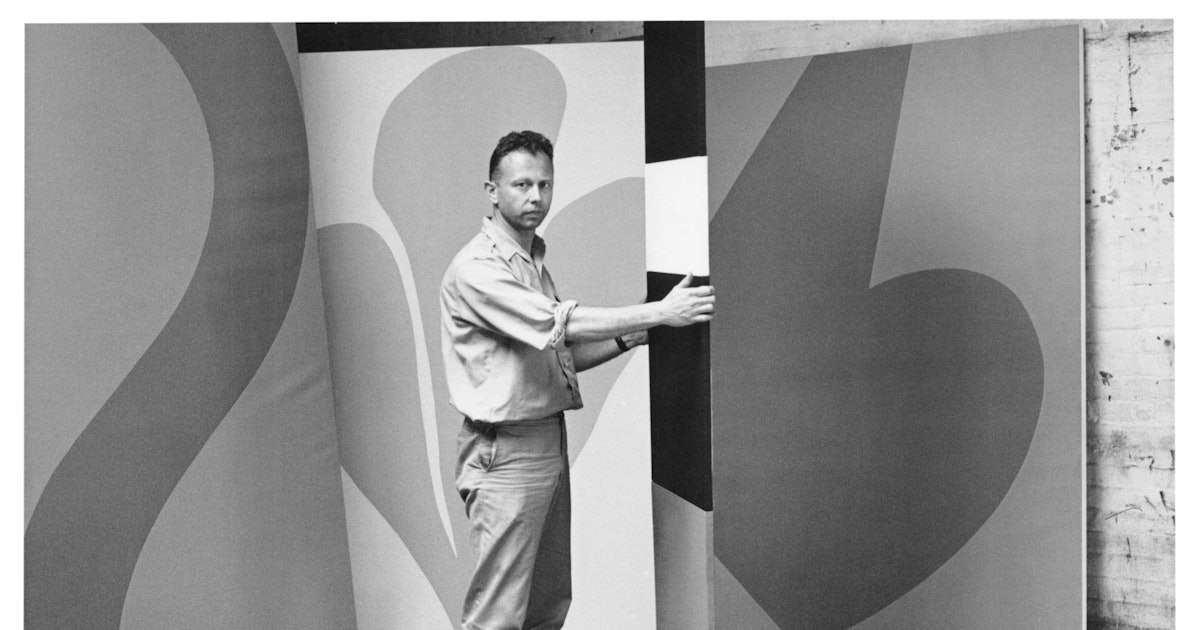Last year, Ellsworth Kelly, who passed away in 2015, would have turned 100. The milestone spawned an ongoing celebration of one of America’s most beloved and prolific masters, starting with “Ellsworth Kelly at 100” last year at the Glenstone Museum, in Potomac, Maryland. A continuing survey of his work, “Ellsworth Kelly, Shapes and Colors, 1949-2015,” just opened at the Fondation Louis Vuitton, in Paris, and will remain on view until September 9.
The venue makes perfect sense. Kelly, after all, lived in France in the late 1940s and early 1950s, a formative period of his career. But perhaps most important, Kelly’s final commission, completed in 2014, was made for the Fondation. The Frank Gehry building, located on the outskirts of Paris, had just been completed, and there was a soaring auditorium that anchored the space. Kelly was tapped to create a permanent “curtain” for its stage—Spectrum VIII, a monumental piece consisting of twelve joined panels. He complemented it with a long yellow strip, blue and red incomplete squares, and green and purple rectangles that were hung in the surrounding walls.
An installation view of Ellsworth Kelly’s Spectrum VIII, 2014
© Ellsworth Kelly Foundation © Fondation Louis Vuitton
Those pieces are a focal point of the retrospective, which touches upon all aspects of Kelly’s oeuvre, including painting, works on paper, collages, photographs, sculptures, and installations. “It has a breadth to it that’s important,” says Jack Shear, the president and director of the Ellsworth Kelly Foundation, who was Kelly’s life partner for over three decades. Shear, a photographer whose pictures of Kelly’s studio after the artist’s death are included in a side room, worked closely with the Fondation’s artistic director, Suzanne Pagé, on the installation of the artworks. “Ellsworth had a particular vision of how he saw his paintings and how he saw his work,” Shear says. “I knew him so well, I just tried to channel what he would have done.”
Ellsworth Kelly, Blue Curves, 2014
© Ellsworth Kelly Foundation
The show begins with modestly scaled tableaus that Kelly created while in Paris, where he landed after serving in the Army during World War II and studying under the GI bill at Boston’s School of the Museum of Fine Arts. In those early pieces, he was clearly searching for a way to simplify and abstract what he observed. At that time, artists like Picasso and Matisse ruled the day, but Kelly wasn’t interested in painting people; after those towering giants, what could be done with the human figure? Instead, he focused on fragments—be it architectural details, the slope of a hill on a field, or the shadow cast by the sun on an open book. Pure form, color, and scale became his métier.
An important breakthrough happened in 1952, when Kelly created what he considered his first monochromatic painting, following a visit to Monet’s home and studio in Giverny. “It’s not monochromatic at all,” says Shear, laughing, as he shows me a beautiful work in mottled greens with hints of blue that brings to mind the background of Monet’s famous waterlilies. “But for Ellsworth, it was.” After that, Kelly worked exclusively in his signature flat, uniform style.
In the decades that followed, Kelly’s reach grew in both scale and refinement, his paintings becoming totem-like objects of purity, poetry, and grace. Many accolades came his way, including midcareer retrospectives at MoMA in New York, the Centre Pompidou in Paris, and the Stedelijk Museum in Amsterdam. A highlight of the exhibition at the Fondation is Yellow Curve, Kelley’s first floor painting, for which a room was specially built when it was initially displayed, in Frankfurt in 1990.
Ellsworth Kelly, Yellow Curve, 1990
© Ellsworth Kelly Foundation Courtesy Glenstone Museum, Potomac, Maryland, © Ron Amstutz
And yet, Shear recalls that, for years, Kelly was not quite fully understood. He couldn’t be neatly placed into the prevailing artistic movements of his time, like abstract expressionism, pop art, or minimalism. “He was considered too French for the Americans and too American for the French,” says Shear. “Maybe it would have been better for him back then to fit in. But in retrospect, it’s better that it was that way. He was an anomaly, so he stands on his own.”
Towards the end of the exhibition, there is a series of photographs taken by Kelly. The snapshots are crisp, arresting vignettes of farmhouses, streets, and landscapes. If you take a few steps away from them and squint, you see only elemental forms. An open garage door, for example, becomes two white blocks and a black one—not unlike the depurated black and white canvases that hang nearby. “For many years, Ellsworth didn’t like people seeing his pictures,” Shear says. “They were just aide-mémoires for him, records of how he saw the world, like notes.”
For an eagle-eyed viewer, however, they offer much more than that: they are a window into a singularly pure creative process. Shear sums it up with a phrase he remembers Kelly was fond of saying: “If you turn off your mind and only look with your eyes, everything ultimately becomes abstract.”
Ellsworth Kelly, Atlantic, 1956
© Ellsworth Kelly Foundation
